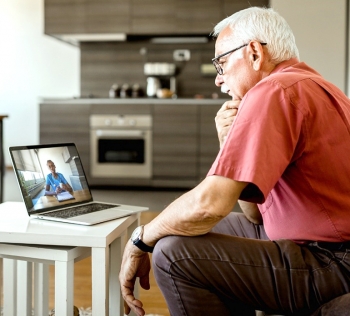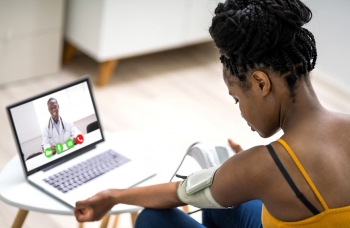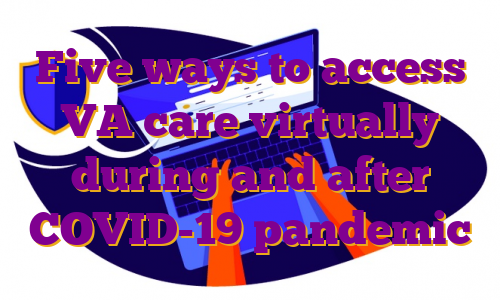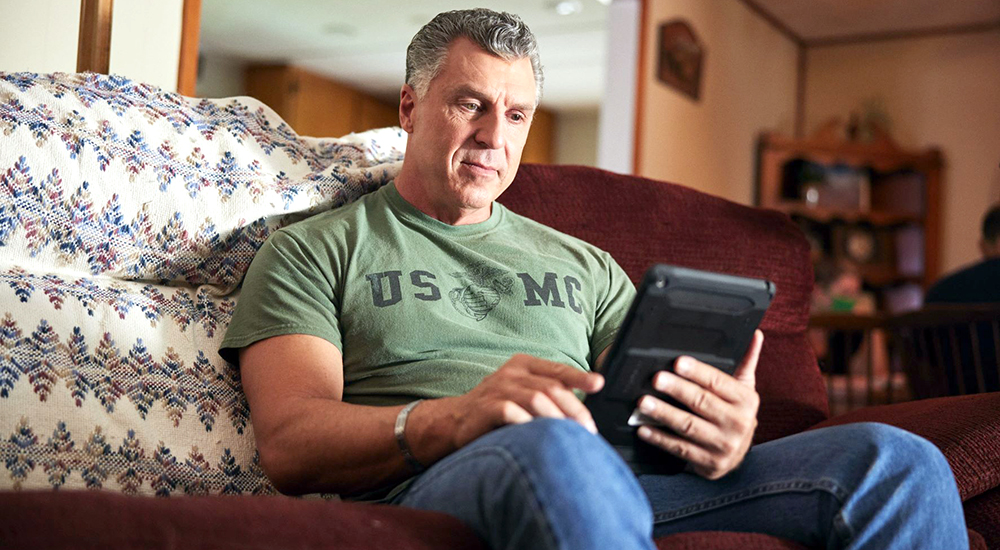This March marks a difficult anniversary: two years since the COVID-19 pandemic began. In that time, all of us have been affected by COVID-19 – most of all, those who have lost loved ones to the virus.
We all want to return to a sense of normalcy. To keep the most vulnerable members of our communities safe, please continue to follow the precautions deemed necessary in your area. And to keep yourself and your family safe, get the COVID-19 vaccine and booster shot if you are able to do so.
Here are five ways that Veterans can access VA care safely and easily from home. And remember, these virtual resources are available to you anytime – whether it’s related to COVID-19 or not.
1. Get mental health care through telehealth
If you are feeling stressed, anxious or depressed, or if you feel that the pandemic is making your mental health symptoms worse, speaking with a mental health provider is an important first step.
 Switch to a video visit to reduce your risk of COVID-19 exposure.
Switch to a video visit to reduce your risk of COVID-19 exposure.
You can meet with a VA mental health provider through VA Video Connect, VA’s secure videoconferencing app. You can set up a video appointment from home, and there is no copay for using VA Video Connect. For more information, contact your local VA medical center.
If you need immediate mental health support, contact the Veterans Crisis Line by calling 800-273-8255 and pressing 1, or text 838255. It’s free and confidential.
2. Switch from in-person appointments to video visits
Video visits are designed to fit easily into your daily routine. Using VA Video Connect, you can meet with your VA care team over a secure video connection from wherever you are. There’s no need to drive to a VA medical center or clinic or wait in the waiting room.
You can switch to a video visit if you want to stay home to reduce your risk of COVID-19 exposure – or if you just prefer receiving care from home.
A video visit may be a good fit if getting to a VA facility is difficult for you, if you need to stay home to care for kids or other family members, or if you’re too busy to make time for an in-person appointment.
“Veterans can choose a VA Video Connect visit if they prefer staying home because of the omicron variant or for any reason,” said Dr. Leonie Heyworth, clinical deputy director at VA’s Office of Connected Care. “It can be simply because they prefer the convenience of meeting with their VA care team from home.”
And if you want to include family members or other caregivers in your VA care decisions, you can add them to the video visit so they can participate from anywhere.
Video visits are free and are a good fit for many primary care and mental health visits.
To learn more about switching to a video visit, read this VAntage Point article.
3. Use the Annie app if you have vaccine side effects or if you test positive
The Annie App for Veterans sends automated text messages that can help you learn about COVID-19, cope with stress related to the pandemic and support you if you are exposed to or test positive for COVID-19.
If you just received or are about to receive the vaccine or a booster shot, text messages from Annie can help you learn what side effects you could experience.
 Veterans measure their vital readings and send them securely.
Veterans measure their vital readings and send them securely.
If you test positive for COVID-19, Annie can check on your symptoms and give you guidance on when to seek care if your symptoms worsen – or when you can stop isolating once you feel better.
Annie can also send messages to help Veterans cope with feelings of stress, isolation or fatigue related to the pandemic.
To learn more, visit the Annie app page on the VA App Store.
4. Find your VA COVID-19 test results and vaccine records on My HealtheVet
If you received a COVID-19 test or the COVID-19 vaccine at VA, you can use your My HealtheVet Premium account to find your test results or vaccination record online.
To find your COVID-19 test results, follow these steps. And if you want to locate your COVID-19 vaccination record, follow these steps.
Don’t have a My HealtheVet Premium account? Premium accounts are free. And you can get one in person at a VA facility or online by following these instructions. Along with accessing COVID-19 information, you can use My HealtheVet to request refills of your VA prescriptions, find your VA medical records and exchange secure messages with your VA providers.
5. Have your VA care team monitor your chronic condition or COVID-19 recovery
VA’s Remote Patient Monitoring – Home Telehealth (RPM – HT) program lends a hand to help Veterans manage chronic conditions, like diabetes or heart disease.
Veterans measure their vital readings and symptoms and send them securely to their assigned RPM – HT Care Coordinator for review. The Care Coordinator collaborates with the Veteran’s care team to help the Veteran manage their care.
Over the past two years, the RPM – HT program has helped Veterans who are recovering from COVID-19 at home.
U.S. Marine Corps Veteran Michael Novielli took part in the RPM – HT program after contracting COVID-19 in April 2020. When his RPM – HT Care Coordinator noticed unusual symptoms, she helped Novielli get in-person care quickly.
“If I wasn’t on the telehealth, I would have stayed home with the pneumonia,” Novielli said. “And who knows what would have happened?” Read his full story on VAntage Point.
Ask your VA provider if RPM – HT is a fit for your care needs and learn more on the Telehealth Services website.

✅ خرید وی پی ان ❇ ip ثایت vPn آی پی اختصاصی ◐
✅ خرید VPN آی پی ثابت ترید بایننس وی پی ان ◐ ip اختصاصی اکانت آی پی ثابت

